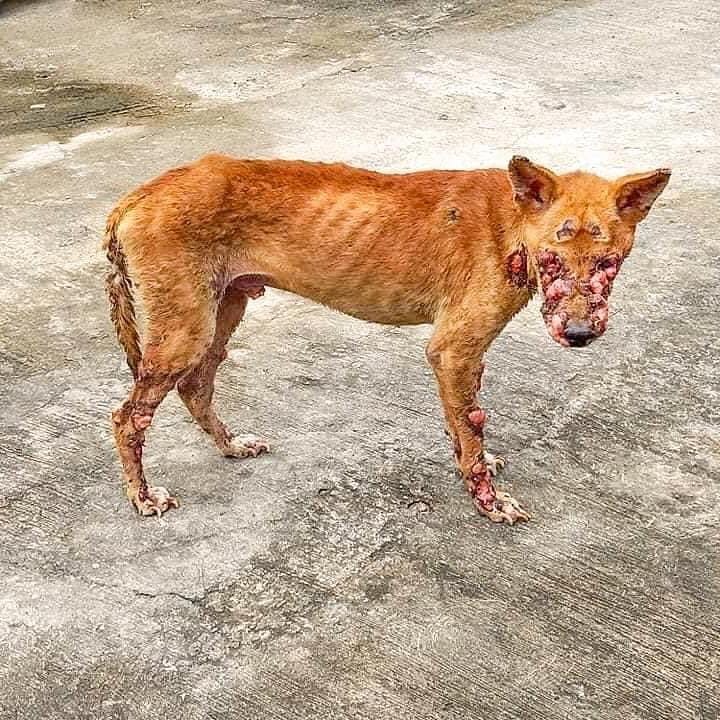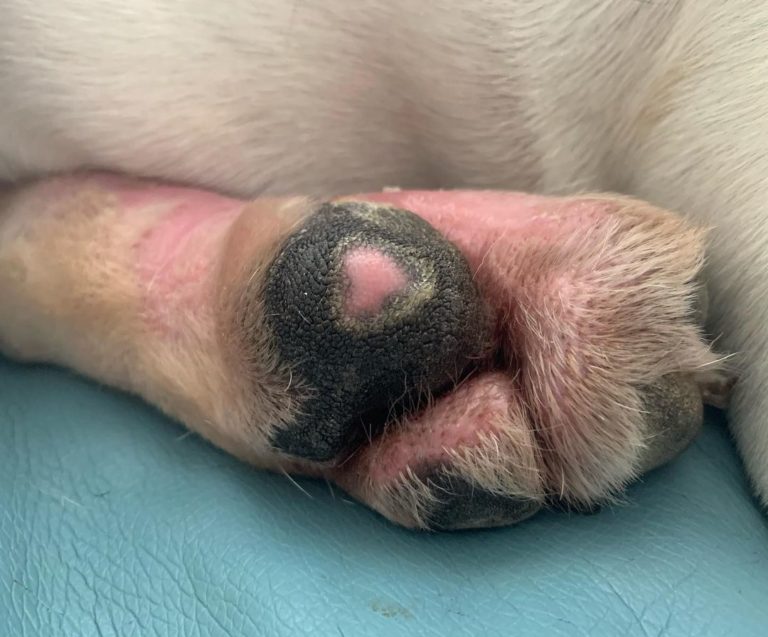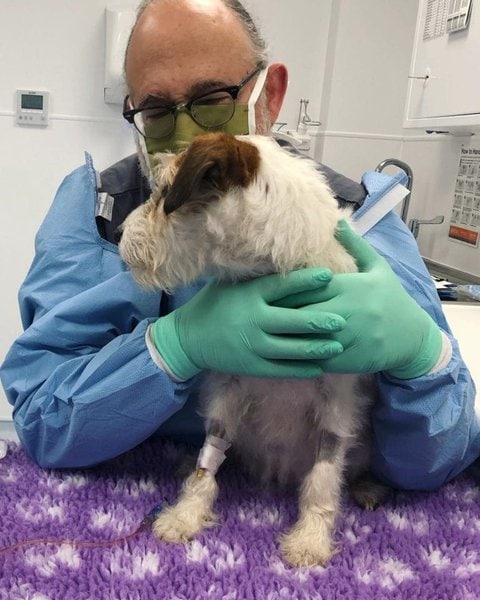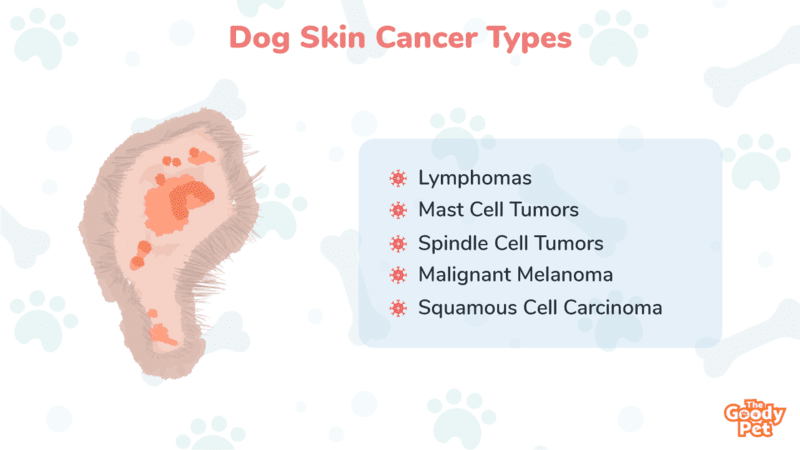Skin cancer in dogs is the most common type of cancer. The three most common types of skin cancer in dogs are:
- Squamous cell carcinoma: This type of skin cancer usually appears as a raised, ulcerated growth on the dog’s skin. It is most commonly found on the dog’s head, neck, or legs.
- Basal cell carcinoma: This type of skin cancer usually appears as a raised, bald spot on the dog’s skin. It is most commonly found on the dog’s chest or belly.
- Malignant melanoma: This type of skin cancer can appear as a black or brown growth on the dog’s skin. It is most commonly found on the dog’s skin folds, ears, or nose.
If your dog has a growth or lesion on its skin that does not go away on its own, please consult your veterinarian.
Your vet will examine the growth and may recommend a biopsy to determine if it is cancerous. If the cancer is confirmed, treatment options will depend on the type of cancer and how advanced it is.
Common treatments for canine skin cancer include surgery, radiation therapy, chemotherapy, and topical ointments or creams. It is important to work closely with your veterinarian to develop an appropriate treatment plan for your dog’s specific condition.
What Are The Types Of Dog Skin Cancer?

Skin cancer on dogs looks very different depending on the type of the tumor and the stage. For perspective, here is a list of 5 of the most common types of skin cancer in dogs, their appearances, and their potential outcomes.
Mast Cell Tumors
Mast cell tumors form the most common type of skin cancer in dogs. Despite being so common, they are often misdiagnosed as allergic reactions. This is because they produce histamine which triggers non-specific irritation.
Squamous Cell Carcinoma
Squamous cell tumors on the other hand are the most easily and most commonly diagnosed when it comes to dog skin cancer. They occur mainly in older dogs and are associated with sun exposure. They present as raised lumps or areas of inflammation that are painful when touched.
Malignant Melanoma
These tumors are relatively easy to diagnose when picked early and can be identified through their signature darker appearance compared to the rest of the skin. It could be a flat wart-like lesion or a raised growth and they mainly appear on exposed surfaces like lips, the nose, nailbed, and paw pads. It is one of the most problematic types of skin cancer as it spreads quickly in dogs to other vital systems.
Spindle Cell Tumors
These are known as Fibrosarcomas and feature invasive growth of fibrous tissue in the skin. They occur mainly on limbs and are unique in that they can attack dogs at pretty much any age. The biggest issue with spindle cell tumors is that they are likely to recur even after successful treatment.
Lymphomas
Strictly speaking, lymphomas are not technically skin tissue tumors but instead cancer of blood cells. Manifestation on the skin through painful bumps is usually a sign of the final stages of lymphomas in dogs involving widespread and often fatal metastasis.
What Are The Signs Of Cancer In A Dog?

Most forms of skin cancer can be a little tricky to identify. More often than not this is a result of confusion between dog skin cancer and other skin conditions like warts and skin tags. To help you out, here are some of the most obvious signs of dog skin cancer that you could use to tell if your dog is suffering.
Unusual Lesions On The Skin
These take different forms including wart-like lesions, open sores, raised bumps, skin hot spots, and even protruding growths. As earlier mentioned, different tumors present differently depending on their specific pathological basis.
Rapidly Growing Skin Lesions And Ulcers
One of the best ways to differentiate between cancerous lesions and those from benign growths or infections is the time they take to grow.
Unlike infections, these lesions will appear slowly and progress over a few months. However, their growth is noticeably faster and more seemingly exponential than that of benign tumors.
Painful Lesion
These skin cancers also more often than not tend to be painful. This is because, unlike the benign ones, they are invasive and tend to affect nerves making them particularly tender especially when touched which is the best way to know your dog is in pain from cancer.
Intense Itchiness
This is the case mainly with mast cell tumors that tend to produce histamine that causes irritation and itchiness. However, it could also be due to the other tumors in cases of ulceration and infection.
Non-Specific Symptoms
In addition to the specific signs and symptoms on the skin, you may also notice some vague changes in the pooch’s behavior. This is often a symptom that canine skin cancer has spread and is affecting the functioning of other systems. The signs here include weight loss, fatigue, whining, and loss of appetite.
What Can You Do For A Dog With Skin Cancer?

The answer to whether or not skin cancer can be cured depends on several factors. These determine not only the rate of progression and intensity of cancer but also the treatment options and most likely outcomes. Let us take a look at 3 of the most influential factors that will determine whether or not your dog’s skin cancer can actually be cured.
Type Of Skin Cancer
This determines things like the level of invasiveness of the tumor and the response to treatment. Some tumors like mast cell and squamous cell cancers are easily removed through surgical means with little to no need for adjunct therapy like chemo or radiation.
Other tumors like lymphomas and melanomas, on the other hand, need very powerful combinations of all 3 therapies if your dog is to have any chance at surviving.
Stage Of The Cancer At The Time Of Discovery
With all types of malignancies including skin cancer, it goes without saying that cancers that are detected early are easy to treat. This is because the chances that it has spread beyond the skin are much lower.
However, with subtle cancers like mast cell tumors or aggressive ones like melanoma, the discoveries are often made very late and therefore reduce overall cure rates. This is one of the main reasons why dogs die from skin cancer.
Dog’s Age And Overall Health Status
Younger and healthier dogs typically bounce back faster and respond better to different cancer treatments than their older counterparts. This is because they need to be strong for the often brutal therapies.
Can Dog Skin Cancer Be Cured?

When it comes to what you can actually do for your dog with skin cancer, there are 4 main options. What you choose will obviously depend on the type of cancer and the stage. The price also matters because it can be very expensive to treat cancer in a dog with costs of up to $9000 or more. Let’s dive right into your options.
Surgical Removal Of Tumors
When it comes to non-aggressive tumors and those that are caught early, this is without a doubt the best option. Surgical treatment is also the most affordable option and will set you back only $300 to $1000 to remove a tumor from a dog depending on the size and number.
Radiotherapy
Radiotherapy is used to deal with harsher and more invasive tumors. While not effective on its own, it has been shown to increase the overall effectiveness of surgical and drug therapies for skin cancer.
Chemotherapy
This is the most effective method of dealing with more advanced stages of skin cancer, especially where metastasis is suspected. Dogs typically live for 10 to 12 months after chemotherapy but survival rates of 2 years or more are not completely unheard of. It is, therefore, safe to say that chemo is worth giving a try when dealing with dog skin cancer.
Euthanasia
Finally, sometimes, the best thing to do for your dog with skin cancer is to put them down.
Remember that skin cancer is painful for dogs and so are the three treatments highlighted above. If your dog has lived a good life and cancer has progressed too far, this may be the most humane course of action.
How To Prevent Dog Skin Cancer?
There is no specific cause of skin cancer in dogs that if avoided will give full immunity from ever developing the tumors. However, there is a lot you could do to minimize the risk by avoiding factors that make your dog more likely to suffer the horrible disease. Below are a few things you could do to help prevent dog skin cancer.
Go Organic With Your Meals
A lot of dog food options out there are just overflowing with artificial additives from preservatives to flavor enhancers. A lot of these chemicals have been linked to cancers including skin tumors. We recommend you go the all-natural route with options such as Ollie. In addition to the natural ingredients and additive-free formula, the food is frozen while fresh ensuring your dog gets the healthiest and safest meals out there.
Protect Your Pooch From The Sun
Excessive sun exposure has been linked to different skin cancers including melanomas and squamous cell tumors. To protect your furry bestie, take measures to protect them from this through things like providing shaded outdoor play areas, investing in dog clothes, and of course, applying dog sunscreen.
With the latter, try out the SIT STAY FOREVER Dog Sunscreen. It is free from toxic chemicals like zinc, titanium, benzenes, and many others. It is also enriched with natural oils including coconut oil, olive oil, and shea butter to further improve skin health.
Neutering
Some skin cancers like malignant melanomas have been shown to be sensitive to sex hormones like estrogen. Neutering could therefore come in handy when it comes to their prevention as well as reducing the risk of other hormone-dependent cancers like ovarian and breast cancer in dogs.
Make Vet Visits Regular
This may not necessarily prevent the tumors but it does increase your chances of successful treatment with early detection. In addition to regular visits, do not ignore any skin lesions even those that look like harmless skin tags or warts. It is better to get them checked out professionally just to be safe.
Related Questions
Can Coconut Oil Heal Skin Cancer?
Coconut oil cannot itself heal skin cancer. However, it is popular in formulations for both the prevention and management of tumors. With the former, it helps keep the skin generally healthy and offers some degree of sun protection. With treatment, coconut oil helps soothe irritated tumor hotspots making life easier for the dog.
Does A Dog’s Skin Darken With Age?
A dog’s skin could darken for a lot of reasons including old age. With age, different factors play a role including hormones, cumulative sun exposure, and general effects of aging on the skin. However, darkening could also be due to ominous reasons including some types of cancers as well as diseases like allergies and acanthosis nigricans.
Is Dog Skin Cancer Contagious To Humans?
Dog skin cancer is not contagious to human beings at all. Cancer is a disease of a genetic mutation that cannot be transferred even with close contact with open tumor lesions. The same case applies to other dogs that the affected pooch may come into contact with. However, tumors caused by papillomaviruses may be contagious to other dogs in which case it is the virus that is spread and not the tumor itself.





